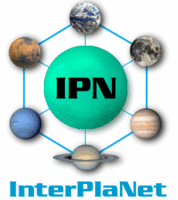
The concept of "Interplanetary Internet" is my latest fascination and obsession! Its an interesting concept of networking the sky, with each orbiter, rover, space borne telescope, and any other skyward launched device as nodes! Sounds simple? Huh - unfortunately no!
According to Vinton G. Cerf (along with Robert Kahn, he was instrumental in designing the Internet protocol , whom I met 2 years ago when they visited UCL to inaugrate a week long series of seminars, to celebrate the 30 years of the Internet) wirelessly conversing with Mars-orbiting craft which is 200 million km away is an impossible challenge.
Infact NASA has successfully transferred a file between the Goddard Space Flight Center and the ill-fated Columbia which was soaring almost 600 km above Earth in February 2003 using the current Internet Protocols. This experiment was called "CANDOS" - Communication and Navigation Demonstration on Shuttle.
So why is it not possible in space? - The main factor is the transmission delay. It takes over a second for light to travel to the moon and it takes almost 15 minutes for the light from Mars to reach Earth!! That is a staggering 30 minute round trip time which is unsuitable for the current TCP implementations!! Another problem is the so called "handoff" problem since the nodes in space are not stationery and they are constantly moving. Thanks to the advent of Mobile IP, this problem can be fixed since Mobile IP allows the moving node in space to be in contact with one of the NASA's scattered ground stations.
Kevin Fall, who is a member of NASA's jet propulsion laboratory (JPL) and a researcher for Intel, came up with this concept of Delay Tolerant Networking (DTN). DTN allows data to travel across networks that have long delays and noisy connections. DTN introduces the concept of "bundling", a mechanism for space network's nodes to hold data if the next hop in the network is unavailable. This could be called as the store and forward network too. Thus a DTN router keeps a copy of every packet of data sent, until the next node in the path has sent a message saying that it has received it. For eg, if a relay satellite along an Interplanetary Internet slips behind the other side of a moon, a router on a DTN network would simply hold onto the data until that relay satellite reappeared, or until another node came into position to provide the necessary hop.
While the DTN protocol is hugely inefficient when compared to Earth's networking standards, it is a surefire way to get data to its destination which is thousands of miles away.
If this sounds interesting, why not check this out : http://www.ipnsig.org/techinfo.htm
5 Comments:
DTN sure looks the only way now, probably a lot of work is going into Data compression techniques too. Reduce the amount that u want to send.
A nice piece of information Arjun.
Yes aatma - data compression is definitely very important..
Aatma - Check this RFC - if you are interested in header compression..
http://www.faqs.org/rfcs/rfc2507.html
defintely Interplanetary Internet wud be the next big thing 2 come since the advent of the Internet.
thanks 2 the nice quick intro about DTNs..
Krishna - you are welcome :)
Post a Comment
<< Home